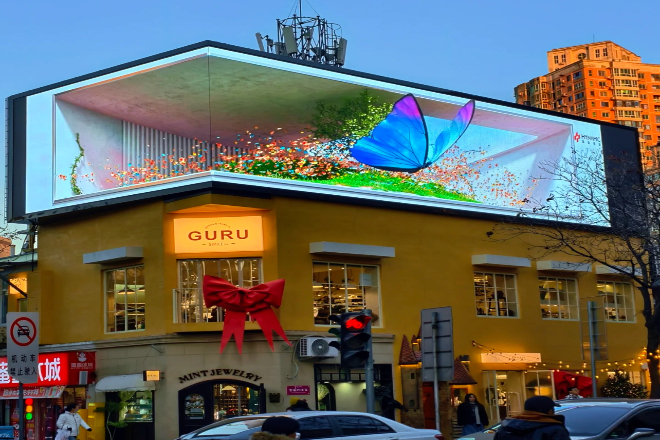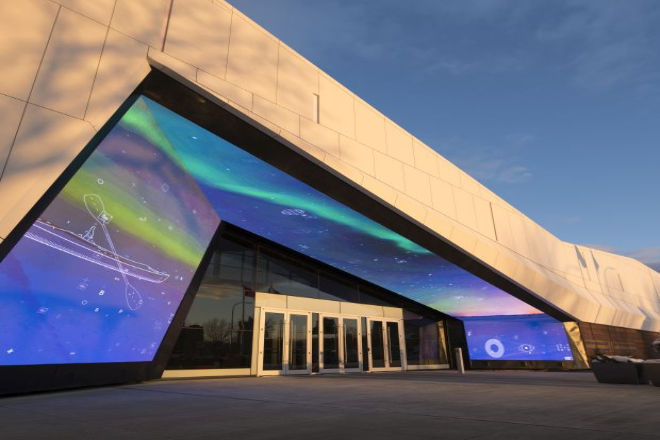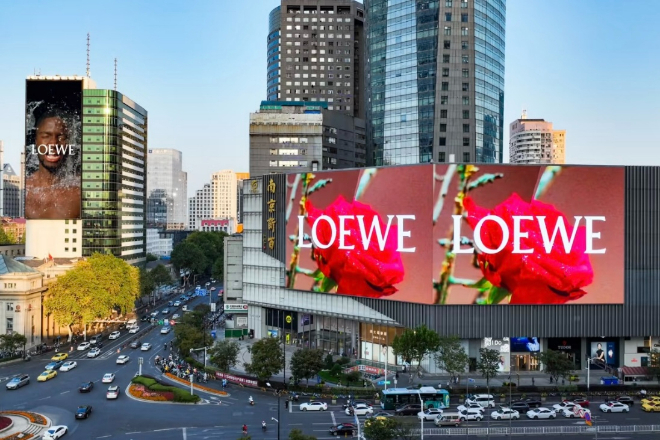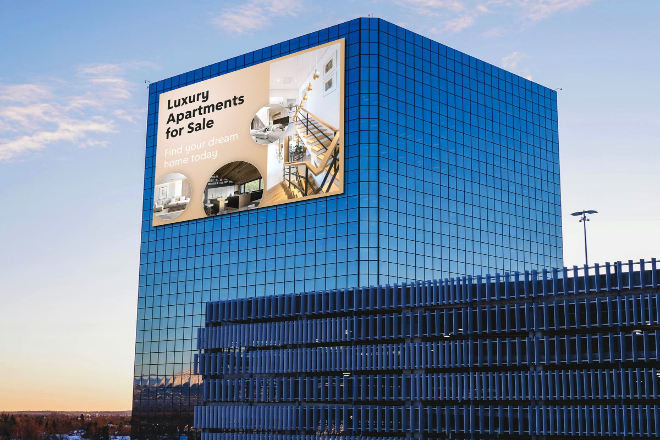مقدمة
In addition to those ancient buildings and beautiful scenery, what else can a city’s charm be shown through?
Now, many cities are very “advocating” شاشات LED, so can LED display screens become the “visual business cards” of smart cities?
جدول المحتويات
1. Why do smart cities need visual "business cards"?

1). Make the city more “face-saving”
1.1). Show the highlights of the city:
Each city has its own characteristics, such as beautiful scenery, unique architecture, rich culture, etc.
The visual “business card” is like a super cool display window, showing these highlights of the city so that others can remember the city at a glance, just like the giant pandas in Chengdu and the West Lake in Hangzhou, which is impressive.
1.2). Attract people and money:
Nowadays, competition between cities is fierce. Who doesn’t want their city to be more popular?
With a visual “business card”, the city can attract more people to travel, work, and live, and can also attract more investment to make the city’s economy more developed.
2). Help the city “manage its home”
2.1). Make data “understandable”:
There are all kinds of data in the city, such as traffic flow, air quality, population distribution, etc. These data may be difficult to understand just by looking at the numbers.
But by turning them into intuitive charts, maps or animations through visual “business cards”, city managers can easily grasp the operation of the city and make more reasonable decisions.
2.2). Improve management efficiency:
With visual technology, many problems can be discovered and solved more quickly.
For example, through cameras and intelligent recognition, illegal parking, littering, and other behaviours can be automatically discovered, and timely reminders or processing can be made to make the city cleaner and more orderly.
3). Make smart city construction more “feeling”
3.1). Make residents more “feeling”:
Smart city construction sounds very grand, but many people may not feel what it has to do with their lives.
Visual “business cards” can intuitively display the results of smart city construction, such as smart transportation, smart security, etc., so that people can truly feel the convenience and benefits brought by smart cities.
3.2). Promote technological development:
There are actually many high technologies behind the visual “business card”, such as high-definition display, virtual reality (VR), augmented reality (AR), etc.
Creating a visual “business card” can promote the development and application of these technologies, making the city more technologically advanced.
4). Make tourism more “fun”
4.1). Improve the tourism experience:
Nowadays, tourism is no longer satisfied with just taking a quick look at the attractions. Visual “business cards” can bring tourists a brand-new experience.
For example, through VR technology, tourists can “immersively” visit the city at home or see more hidden historical stories and cultural backgrounds in scenic spots through AR technology.
4.2). Attract more tourists:
With a good-looking visual “business card”, the city can better promote itself online, let more people know how fun the city is, thereby attracting more tourists to travel and drive local economic development.
2. What is the visual presentation ability of LED display screens?
1). Super eye-catching visual impact
LED display screens are like a super cool “visual trick” that can firmly grasp people’s eyes. It has high سطوع and can be seen clearly regardless of day or night.
High contrast, clear black and white, bright colours, and very comfortable to look at. For example, on the streets of the city, those super-large outdoor advertising screens.
Or the light show at night, once the LED display screen lights up, it can instantly attract people around.
1.1). Case:
على سبيل المثال، naked eye 3D large screen in Chunxi Road, Chengdu, the picture is simply too shocking! The giant panda is vivid on the screen as if it is about to jump out of it, and passers-by can’t take their eyes off it.
This is the power of the LED display screen. It can use this visual impact to show the vitality and charm of the city to the fullest.
2). Can play various tricks
The LED display screen is not an ordinary screen that can only “play a video” and be done with it. It can display a variety of content, including videos, animations, pictures, and text.
Moreover, it can also play various creative ideas according to different scenes and needs.
2.1). Cultural display:
For example, in some historical and cultural blocks, LED display screens can use animations to show ancient life scenes or pictures to show the changes in historical buildings, making people feel that they have travelled through time and space.
2.2). Holiday special effects:
During the Spring Festival, LED display screens can display fireworks and snowflake special effects, making the whole city full of festive atmosphere.
This creative content is not only beautiful, but also makes people feel the warmth and cultural charm of the city.
3). Dynamic update, “online” at any time
LED display screens also have a super powerful ability, which is to update content in real time. It is like a “living” window that can display the latest information at any time.
For example, traffic flow, weather changes, and news information, this dynamic information can be displayed in real-time on the LED screen.
3.1). Traffic information:
At traffic intersections, LED display screens can display road conditions in real-time, telling drivers whether there is a traffic jam ahead and whether they should detour. This not only saves everyone’s time, but also makes traffic smoother.
3.2). News information:
In shopping malls or squares, LED display screens can broadcast news in real-time so that everyone can keep up with the latest news.
This dynamic and real-time nature can not only improve the efficiency of the city’s operation but also make the lives of residents more convenient.
In short, the LED display is like a “super visual assistant” of the city. It can not only attract attention, but also show creativity and update in real time. It is simply an indispensable “artifact” in the city.
3. How to integrate LED display with urban culture
1). Cultural inheritance and display
LED display becomes a disseminator of urban culture by displaying the city’s history, culture, folk customs and other contents.
It can not only display static pictures and texts, but also make culture “live” through dynamic videos and animations.
For example, on the exterior wall of a متحف or a cultural square, LED display can display historical relics, folk activities and other contents, making the audience seem to travel through time and space.
For example, the Piccadilly Circus in London, England, has been a prominent advertising display method since the early 20th century.
Today, it uses a large curved LED screen to display advertisements of various brands and also incorporates London’s historical and cultural elements to attract the attention of passers-by.
2). City image shaping and brand building
In city brand building, visual elements are crucial. LED display screens can shape the brand image of a city through unified design style and theme display.
For example, in the city centre square or transportation hub, LED display screens can display the city’s characteristic activities, advantageous industries and other content to attract investment and tourism.
For example, in Times Square in New York, USA, the LED display screen of Times Square is one of its iconic features, filled with various types of LED billboards and display screens.
They not only broadcast commercials and current news but also promote various works of art. Through unified design style and theme display, they shape the prosperous image of the city of New York and attract millions of tourists every year.

3). Cultural innovation and technological integration
LED display screens give traditional culture new forms of expression through technological means, stimulating innovation in urban culture.
For example, in digital art exhibitions and interactive cultural experiences, LED display screens combine virtual reality (VR), augmented reality (AR) and other technologies to create an immersive cultural experience.
For example, the Canadian Science and Technology Museum, which is located in Ottawa, is one of the most famous museums in Canada.
At the main entrance of the Science and Technology Museum, the large LED screen attracts tourists with its high-quality display effects and avant-garde design.
Through LED display combined with virtual reality and other technologies, it provides tourists with an immersive science and technology cultural experience.
In short, LED display screens have played an important role in urban cultural heritage, image shaping, and cultural innovation, and they have become an important carrier for the integration of urban culture and technology.
4. The role of LED display screens in smart city construction
في المدينة الذكية construction, LED display screens are not just a simple “big TV”. They are actually the important “eyes” of the city’s brain.
By “joining hands” with high-tech means such as the Internet of Things and big data, LED display screens can do a lot of things.
For example, it can collect various information, such as the city’s traffic flow, air quality, etc., and then turn these complex data into easy-to-understand charts or animations.
In this way, city managers can see the operation of the city at a glance, make decisions quickly, and make city management smarter and more efficient.
LED display screens are super powerful in public services!
For example, in terms of traffic, it can display road conditions in real-time, tell drivers where there is a traffic jam and where it is unblocked, and help everyone avoid congested sections.
At bus stops, LED screens can also display the arrival time of vehicles, so that passengers can know what to expect without waiting.
In hospitals, LED display screens can update waiting for information and examination results in real time, making patients and their families less anxious.
If there is an emergency, such as a natural disaster or an emergency, the LED display can also issue early warning information in the first place, telling citizens how to avoid danger and ensure everyone’s safety.
In the commercial field, LED display is simply a “money-making tool”.
Think about it: those large LED screens in shopping malls and squares, playing all kinds of cool advertisements and promotions, can instantly catch the eyes of passers-by and stimulate their desire to consume.
In addition, LED displays can also push personalized advertising content according to the interests and consumption habits of the surrounding people, making marketing more accurate.
This high-tech advertising method can not only enhance the attractiveness of commercial places, but also drive consumption and promote the economic development of the city.
In general, LED display is a “all-rounder” in the construction of smart cities. It can not only improve the level of intelligence of the city, but also improve public services and promote economic development. It is simply a “super assistant” of the city.
5. Visual aesthetics of LED display and urban landscape

1). Consideration of visual aesthetics
The visual aesthetic design of LED displays in urban landscapes is crucial. The colour matching should be harmonious and not too glaring, the shape design should be unique but not abrupt, and the layout planning should be reasonable and not messy.
For example, a circular LED screen is placed in the center of the square, surrounded by soft lights, and the color matching is similar to the surrounding buildings, which looks very comfortable.
Through these designs, the LED display screen can not only display the content but also perfectly integrate with the urban environment to avoid becoming a source of visual pollution.
2). An organic part of the urban landscape
The LED display screen cannot exist alone. It must be integrated with the city’s buildings, streets, squares and other elements to form a unified urban landscape.
For example, on the Champs Elysees in Paris, the facades of some buildings are designed as LED display screens.
They are part of the building during the day and become the stage for light shows at night, which complement the surrounding environment.
For another example, in the lighting landscape of some cities, LED display screens are cleverly embedded in the facades of bridges or buildings. Through dynamic pictures and lighting effects, the entire city is revitalized at night.
3). Visual ecology and sustainability
The sustainability of LED displays in urban visual ecology is also very important.
First, energy-saving design is the key. Today’s LED screens are becoming more and more energy-efficient and can reduce electricity consumption.
Secondly, the service life should be long. A good LED screen can be used for many years and will not be replaced frequently.
Finally, environmental adaptability is also important, such as waterproof and dustproof and can work normally under different weather conditions.
Through these sustainable designs, LED displays can not only serve the city for a long time but also reduce the impact on the environment, such as reducing electronic waste and light pollution.
In short, LED displays are not only a visual focus in the urban landscape, but also a manifestation of aesthetics and sustainability.
Through careful design, it can perfectly integrate with the urban environment and become an indispensable part of the urban landscape.
6. Interactive experience of LED displays and urban residents
1). Expansion of interactive functions
LED displays are now more than just a tool for displaying information. It can also “chat” and “play games” with residents through various high-tech means, greatly enhancing the sense of participation and experience of residents.
For example, some LED screens can be operated by touch, like the shopping guide screens in shopping malls, where customers can check store locations and promotions with just a click.
Some screens can capture your movements through cameras. For example, in a game room, you can interact with the games on the screen by moving your body.
You can even interact with LED screens with your mobile phone. For example, in a science and technology park, employees and visitors can participate in park voting and query the location of facilities through their mobile phones.
These interactive functions have brought residents closer to the screen and made life more interesting.
2). Improving the quality of life of residents
LED screens are also playing an increasingly important role in the daily lives of residents.
In communities, LED screens can publish various information, such as community event notifications, festival arrangements, and even show the style of residents, making the community more cohesive.
In public places, such as parks, LED interactive screens can be combined with treadmills. When residents run, running data and virtual scenes will be displayed on the screen, making the exercise more interesting.
This way of improving the convenience and happiness of life through visual information is making cities more livable.
3). Resident feedback and urban governance
LED screens can also become a “megaphone” between residents and city managers.
For example, some LED screens have set up opinion collection and voting interactive functions, and residents can directly feedback through the screen and participate in the city’s decision-making process.
This kind of interaction not only makes residents more involved but also allows city managers to understand residents’ needs more directly so as to make decisions that are more in line with public opinion.
In this way, LED display screens not only improve the quality of life of residents, but also provide strong support for the refined governance of cities.
7. Future development trends and challenges of LED display screens

1) دمج التكنولوجيا والابتكار
In the future, LED display screens will become more and more “smart” because they will “go hand in hand” with many powerful technologies.
For example, combined with artificial intelligence (AI), the screen can “read” your eyes and movements and automatically push you to the content you are interested in.
Just like when you pass by an advertising screen in a shopping mall, it can recommend products you may like based on your expression.
5G technology will also make LED display screens “fly” faster. With 5G, the screen can update content instantly and can also be seamlessly connected with mobile phones, tablets and other devices.
For example, during live broadcasts of sports events, viewers can interact with the large LED screens on-site through their mobile phones and vote for their favourite players in real time.
New technologies will also make the picture quality of LED displays more “amazing”.
For example, Micro LED technology can make the screen resolution higher and the colours more vivid, just like accurately arranging and combining small light points; the picture details are so clear that they are amazing.
2). Deep combination of culture and technology
The future LED display will not only be a tool for “seeing pictures and talking”, but also a “big stage” for urban culture.
For example, in museums, LED screens can be combined with virtual reality (VR) technology, allowing you to travel through time and space and experience historical scenes in person.
In city squares, screens can play immersive digital artworks, turning the entire square into a huge art exhibition hall.
This combination of culture and technology can make the city’s “visual business card” more attractive.
For example, some building facades in Paris use LED screens to display dynamic light shows, combined with local cultural elements, to attract the attention of tourists from all over the world.
Through innovative content display, cities can not only spread their own culture but also become a place for Internet celebrities to check-in.
3). Challenges and coping strategies
Although the future of LED displays is bright, there are also some “little troubles” that need to be solved.
First of all, the technical standards of various LED screens are now varied, just like different countries do not speak the same language, and it is difficult for devices to “talk” to each other.
Secondly, if the content on the screen is not properly managed, some messy things may appear and even interfere with everyone’s life.
In addition, if there are too many LED screens and they are too bright, it may cause visual pollution and dazzle people.
4). How to solve it?
- Unified standards:
Just like making traffic rules, set a “game rule” for LED display screens that everyone abides by so that devices from different manufacturers can be compatible.
- Strict review:
Just like school teachers checking homework, strictly review the content displayed on the screen to ensure that it is healthy and legal.
- Reduce pollution:
Rationally plan the number and brightness of LED screens to avoid excessive use, just like controlling the brightness of lights, so that the city is both beautiful and not dazzling.
- Environmental protection and energy saving:
Develop more energy-saving LED screens to reduce the impact on the environment, just like using energy-saving light bulbs, which are both economical and environmentally friendly.
In short, the future of LED display screens is worth looking forward to. As long as we solve these small problems, it will definitely bring more surprises and convenience to our lives!
8. الخاتمة
After reading this, do you also think that the new color matching of LED can become the new business card of the city?
From showing the highlights of the city to improving the quality of life, from cultural inheritance to smart city construction, it can show its prowess.
أخيرًا، إذا كنت تريد معرفة المزيد عن شاشات LED، يرجى الحصول على اتصال معنا.
